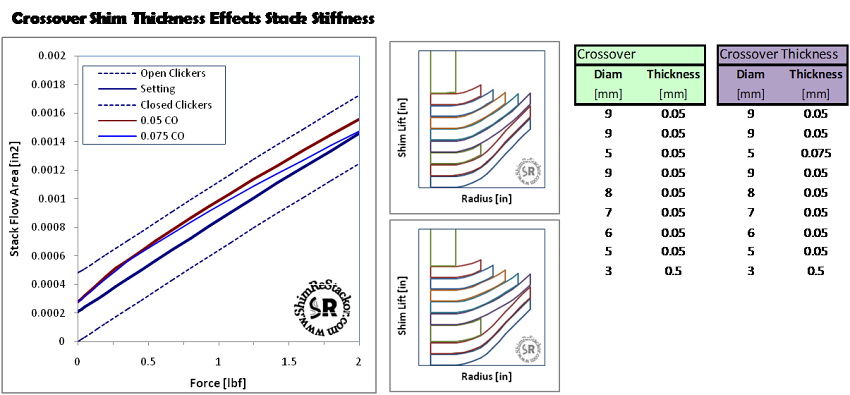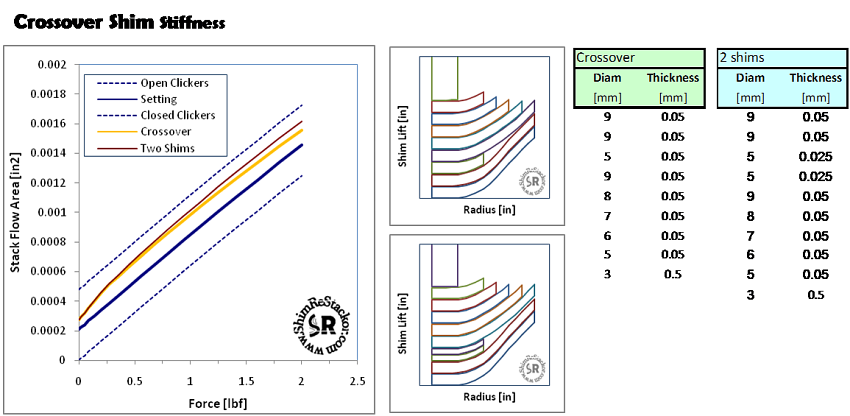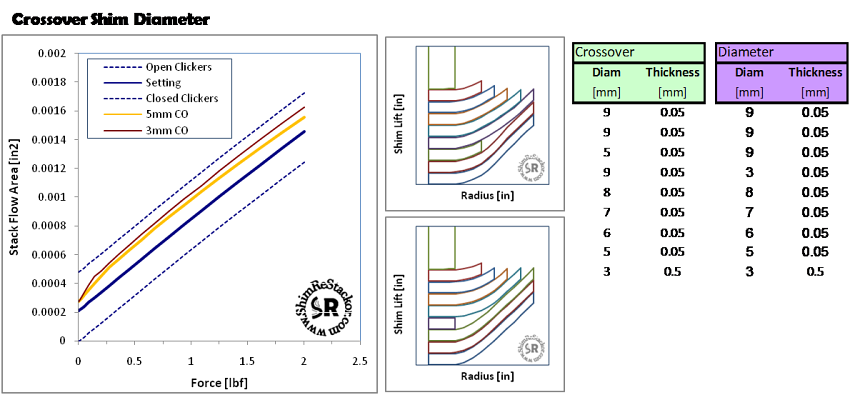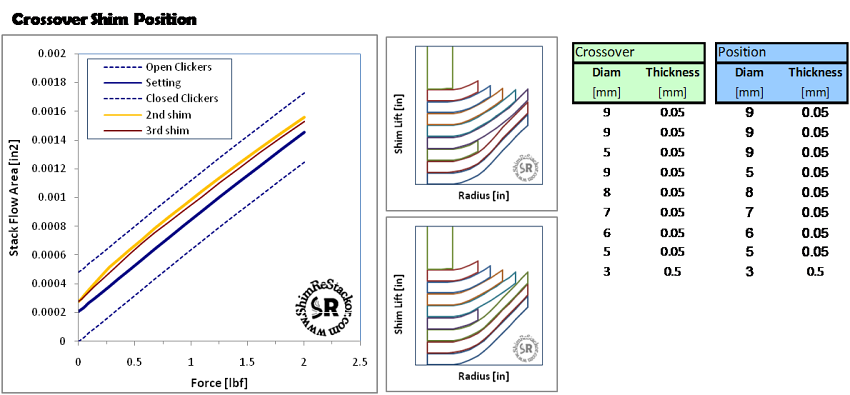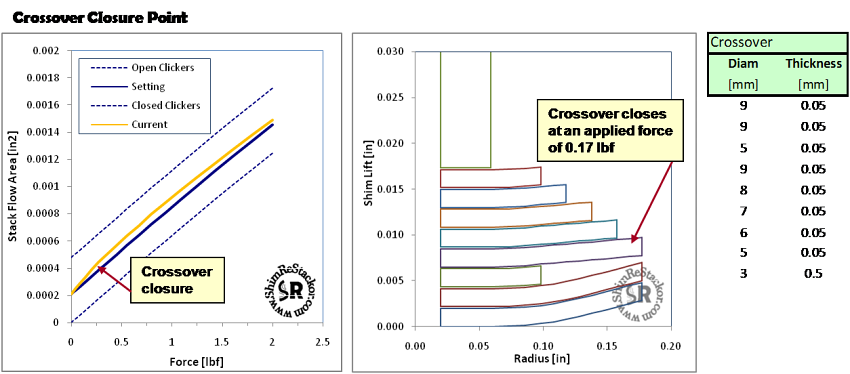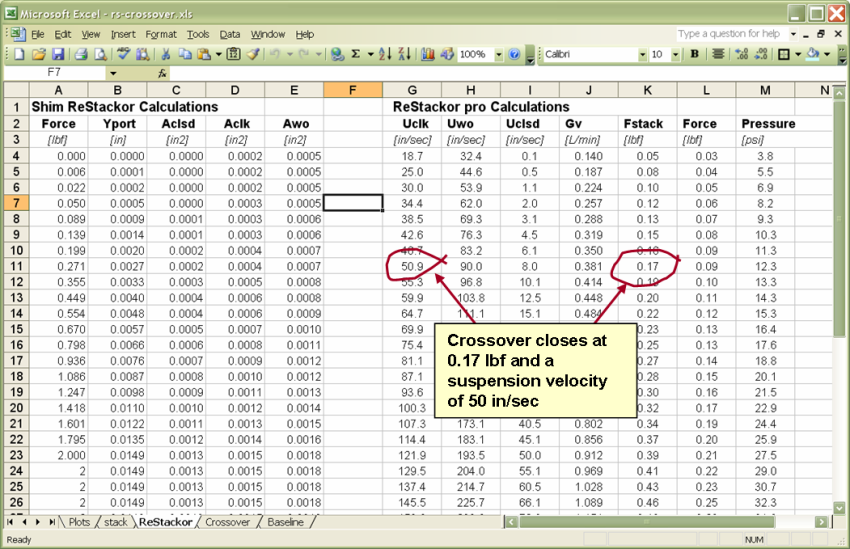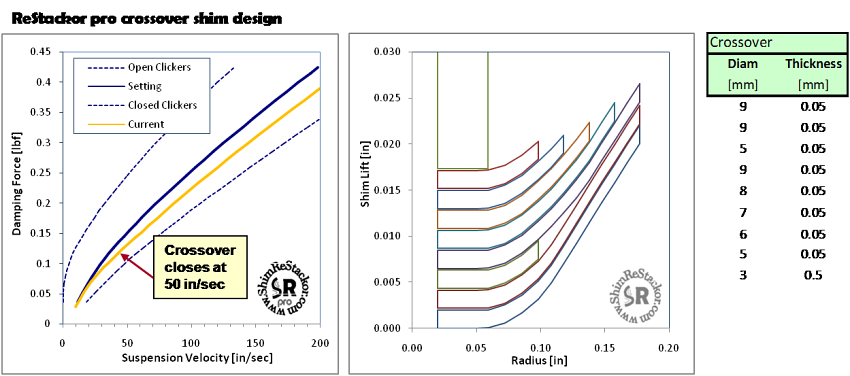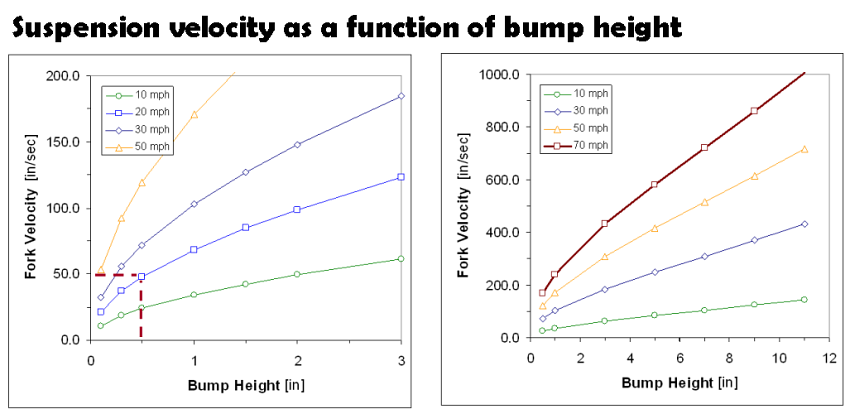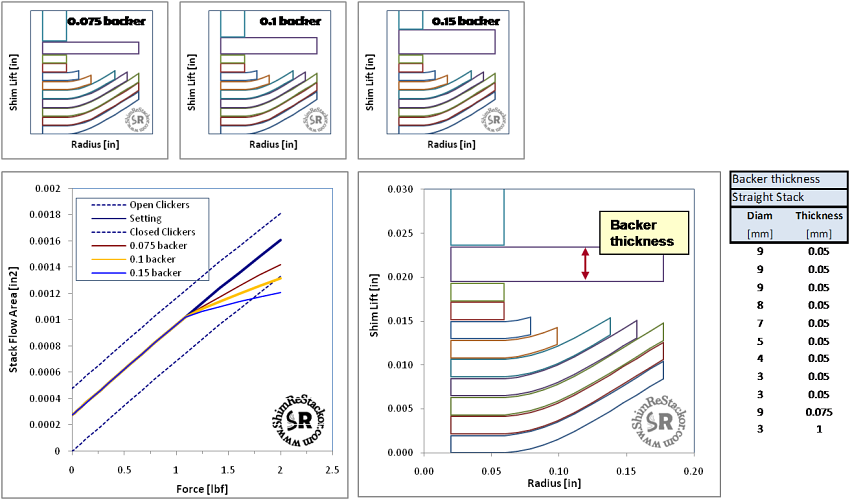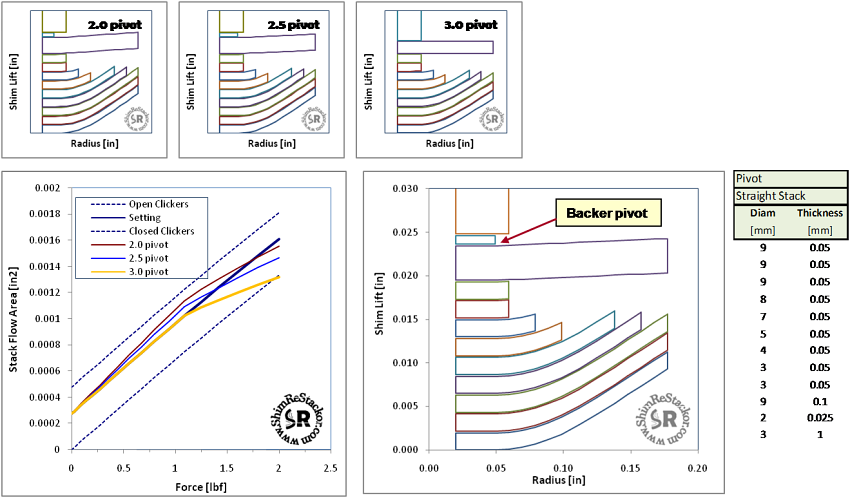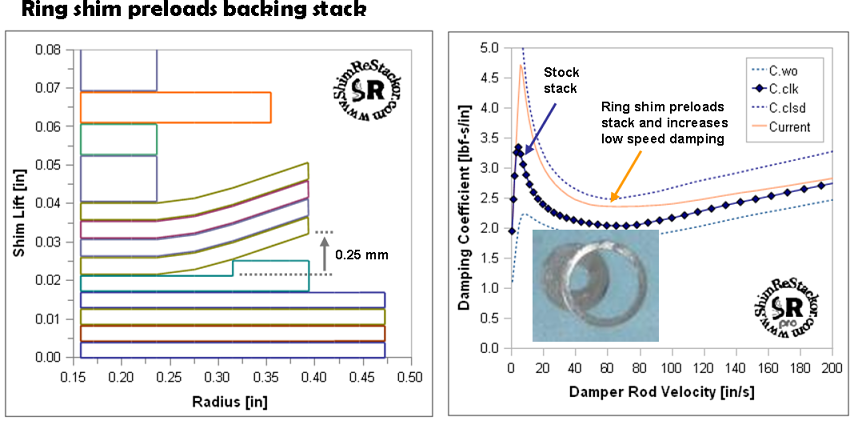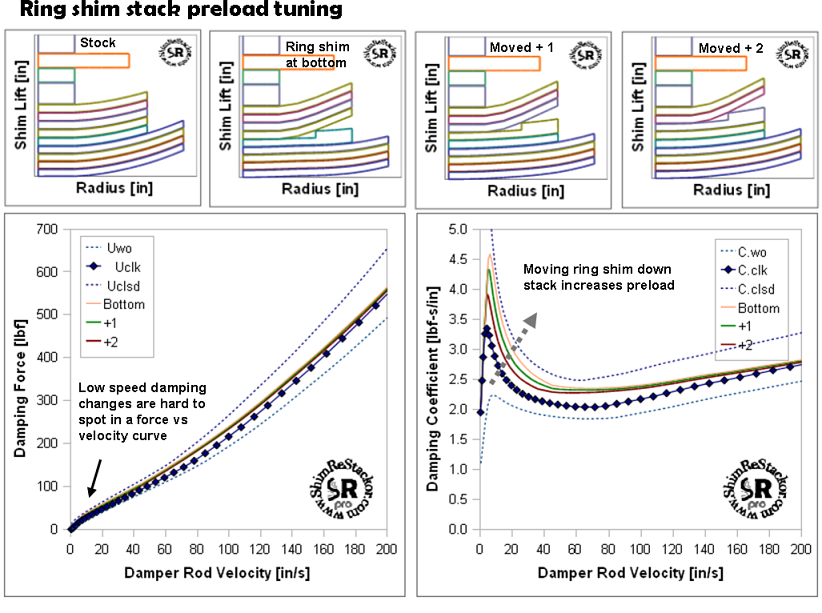

Tuning Basics
Sample Applications

ReStackor Sample Applications
Finally computer software to tune a shim stack
Shim Stack Configuration Styles

There are many different styles of shim stacks from simple straight stacks to complex crossover configurations. Each style has it's own unique features that can be exploited to tune various features of your suspension. The examples below use the demo version of ReStackor so you can follow along and compute your own stacks if you like.
Straight Stack
A straight stack is probably the simplest stack to tune. There are only three parameters: Number of shims; shim thickness and the stack clamp diameter.

-
Number of shims: Controls the stack stiffness. Changes are simple since you don't need to spend much time trying to decide which shim to change.
-
Shim thickness: For tuning you can replace a shim or series of shims with a thinner or thicker shim. Since all of the shims are the same diameter you don't need to have many shims on hand to implement a change to the stack. By the thickness cubed rule three 0.1mm shims are equivalent to one 0.15 shim.
-
Clamp diameter: The stack pivots around the diameter of the clamp shim. Since this effects all of the shims in the stack small changes in the clamp diameter can produce large changes in the stack stiffness.
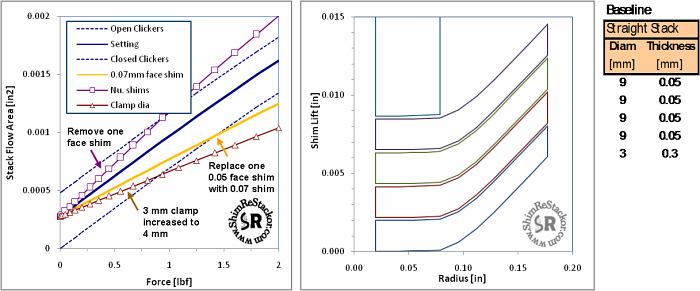
-
Limitations: Since all of the shims in the stack are the same diameter changes in the stack are coarse and produce large changes in damping. At high deflections a straight shim stack produces a sharp bend around the clamp shim. This sharp bend creates a stress concentration and can fatigue or permanently bend the shims destroying the integrity of the stack. Due to the stress concentration at the clamp most shock absorbers use a tapered stack to smooth the bend radius and avoid over stressing the shims.
![]()
Tapered Stack
A tapered stack uses a progression of shim diameters starting behind the face shim down to the clamp diameter. This produces a tapered Christmas tree shape. The taper smoothes the bend radius at the stack clamp and helps to avoid stressing the shims beyond the yield point. The variation in shim diameters used in a tapered stack makes fine tuning adjustments possible, provided you know which shim to change. Tunable features are: the number, thickness and diameter of shims used in the stack taper; the number and thickness of the face shims and the stack clamp diameter.
For the demo stack removing the 7mm shim in the stack taper or changing the clamp shim from 5mm to 4mm makes the stack softer. Increasing the 5mm clamp shim thickness from 0.05 to 0.07mm makes the stack stiffer. Fine tuning adjustments can be made by changing a couple of parameters simultaneously. As an example: you used a thicker clamp shim to make the stack stiffer and removed the 7mm shim to soften the stack. These combined effects would result in a stack that is about 1 click softer.
The capability of ReStackor to evaluate complex stack configurations and relate stack stiffness to clicker settings gives you the capability to fine tune the stack far beyond levels previously possible.
Stack Taper Effects
The face shim bend profile for the straight stack and tapered stack are compared below. Stack taper changes the bend radius of the face shims. By manipulating the bend radius you can influence the fluid flow area at the stack face. In the comparison below the tapered stack produces slightly less flow area at high lift. Through changes in the stack taper you can make the tapered stack produce more or less flow area, in comparison to the straight stack, and change the damping forces at different suspension velocities.
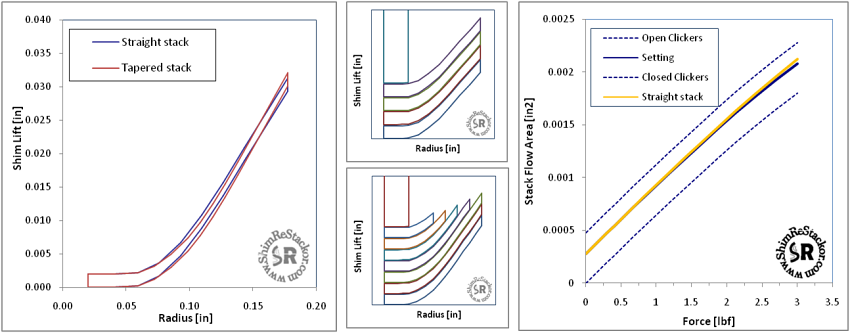
Sample tapered stack produces less flow area at high lift when compared to the straight stack.
![]()
Crossover Shim
Inserting a crossover shim produces a gap at the edge of the stack structure. This creates a separately tunable low speed and high speed stack section. By controlling the crossover shim position, thickness and diameter you can control the stiffness of the low speed stack and the point where the crossover gap closes. Changing the stack taper manipulates the high speed damping rates. While simple in concept there are many design options for the insertion of a crossover shim.
Using ReStackor the design process is significantly simplified. With ReStackor the performance of crossover shims can be evaluated by simply inserting the crossover into the shim stack and clicking the run button to see what happens. If the crossover closes to early you can increase the diameter or thickness of the crossover to tune the closure point. If the stiffness of the low speed or high speed portion of the stack is off you can move the crossover up or down in the stack or adjust the shims in the high speed or low speed portion of the stack to arrive at the stiffness or clicker setting you are looking for. With ReStackor the design process is only limited by your artistic capability to envision the stack stiffness profile you want. If you run out of ideas you can always post your stack on the internet and while you may not arrive at any solutions you will certainly collect many opinions and additional options for investigation with further ReStackor calculations. The capability of ReStackor to tune the shim stack in software gives you an unlimited range of adjustability in your suspension.
Crossover Shim Thickness
Increasing the crossover gap height through the use of a thicker crossover shim makes the stack softer, but the thicker crossover shim also increases the stiffness of the low speed portion of the stack. If you were tuning by the seat-of-the-pants it is easy to understand the confusion surrounding crossover shims.
The thickness of a crossover shim effects both the point where the crossover gap closes and the stiffness of the stack
For the above example a crossover shim thickness of 0.050 softens the initial stiffness for the stack. Above force levels of 0.3 lbf, where the crossover gap closes, the stack approximately parallels the stiffness of the baseline tapered stack. Increasing the crossover gap to 0.075 in an attempt to further extend the low speed range of the crossover, results in a stack with approximately the same low speed stiffness and a stack that is stiffer in the high speed range due to the increased stiffness of the stack root. The above example demonstrates some of the confusion surrounding the design of crossover shims. The stiffness of a stack is not only a function of the gap created by a crossover but also depends on the stiffness of the stack hub or root. Adding a crossover shim to a stack or increasing the thickness of an existing crossover can lead to unexpected effects because of the competing effects of edge gap and stack root stiffness.
The capability of ReStackor to evaluate complex stack structures and accurately compute stack stiffness is a tremendous streamlining of the entire stack tuning process. With ReStackor you can simply put the crossover shim in the stack, click on the run button, and compute the effective stiffness of the stack. With the stack referenced to clicker settings you can instantly evaluate the effect of changes on the stack and if the changes are outside the clicker range you are looking for you can further modify the crossover configuration to get the changes you need. The capability of ReStackor to evaluate the effect of those changes over the entire range of stack deflections helps to avoid unexpected surprizes before you install the stack in your bike. ReStackor gives you the capability to easily evaluate complex stack structures, fine tune features of the stack and evaluate the effect of those changes over the entire range of stack deflection. This gives you the capability to fine tune the stack far beyond levels previously possible.
Crossover Shim Stiffness
The stiffness of a shim is proportional to the thickness cubed. Due to this dependence two 0.025 shims are significantly softer than one 0.05 shim. This allows you to control the stack root stiffness when tuning the crossover gap height.
Using two thin shims to create a crossover gap reduces the crossover shims influence on stack stiffness.
Using two shims instead of one thick shim reduces the effect of the crossover shim on the stiffness of the stack root. You can also use a tapered stack of thin shims as a crossover to influence the stiffness of the face shims as the crossover gap is closing.
Crossover Shim Diameter
The thickness of a crossover shim only effects the stack root stiffness if the crossover shim diameter is larger than the stack clamp. If the crossover shim diameter is the same as the stack clamp it simply becomes part of the clamp as demonstrated below.
The diameter of the crossover shim effects the stiffness of the face shims and the low speed damping rates.
ReStackor gives you the capability to evaluate the effect of crossover shim diameters on the effective stiffness of the stack and tune the crossover shim diameter to produce specific effects in the shock absorber damping profile. The capability to do this in software makes the entire tuning process much easier.
Crossover Shim Position
Moving the crossover shim closer to the face shim reduces the initial stiffness of the stack and causes the gap to close at a lower force level. This gives you the capability to experiment with installing the crossover shim at different positions, determine the point where the crossover gap closes and tune the stack to produce the desired effect.
The crossover shim produces different effects when installed at different heights within the stack.
While the function of a crossover shim is conceptually simply the actual implementation is complex. The crossover shim diameter, thickness and position effects the stack in different ways depending on the specific stack structure you are tuning. ReStackor gives you the capability to accurately evaluate these effects and tune the crossover shim to control the stack structure and produce specific damping profiles. Accurate tuning of crossover shims is a capability that has eluded many tuners in the past.
Designing of crossover gaps to close at a specific suspension velocity
All of the above examples show stack deflection as a function of force applied to the stack. Applying these results to a suspension requires a method to determine the suspension velocity necessary to produce a specific stack deflection force. ReStackor pro provides this capability. For the baseline crossover stack used in the examples above the crossover closes when a force of 0.17 lbf is applied to the stack face.
The point where the crossover closes is easily spotted by the change in slope of the force vs flow area curve.
Running ReStackor pro shows a suspension velocity of 50 in/sec is needed to produce a force of 0.17 lbf on the stack face.
Tabular outputs of ReStackor pro show the fluid dynamic forces applied to the stack face as a function of damper rod velocity.
The point where the crossover closes can be seen in the damping profile plot produced by ReStackor pro.
For a motorcycle fork the suspension velocity is a direct geometric function of the bump height. The relationship is given in the ReStackor users manual and for a 21 inch wheel.
Knowing the suspension velocity as a function of bump height gives you the capability to design crossover gaps to close on a specific bump height.
For a motorcycle the front wheel reaches a suspension velocity of 50 in/sec on a 0.5 inch bump hit at 20 mph. This low velocity is due to the 11 mm valve diameter used in these sample calculations with the demo verison of ReStackor.
With ReStackor pro calculations crossover gaps can be designed to close at a specific suspension velocity. This gives you the capability to design a crossover gaps to float over small ruts and chop and close on larger bumps to give the suspension the damping rates it needs.
![]()
Backing Shims
Many enduro bikes use flow restrictions in the valve ports as a critical element of the suspension system. Valve port flow restrictions allow soft shim stacks to be used to provide plush low speed damping. On big hits the suspension relies on the flow restriction of the valve port to keep the suspension from blowing through its stroke. Many tuners drill out the valve ports out to arrive at a better balance of high speed damping. Modifications of the valve ports are typically accompanied by much engineering hand wringing before drilling the ports since the changes are irreversible.
Shim stack backing shims are another implementation of this same style of suspension system. The "backer" at the top of the stack limits the maximum shim deflection essentially operating as a valve port flow restriction. But there is an important difference. The backer is tunable and that gives you the capability to generate a much broader range of damping profiles then can be produced using valve port flow restrictions.

Gap shims can be installed below the backer to tune the point where the backer comes into play. Changing the height of the gapper shims is equivalent to changing the valve port flow area.
Gapper shims give you the capability to control the point where the backing shim limit stack deflection.
Changing the thickness of the backer changes the slope of the damping curve after the shims hit the backer. An extremely thick backing shim imitates a valve port flow restriction. By tuning the thickness of the backer you can control the slope of the high speed damping curve. The backer gives you a tuning capability that can not be duplicated by a valve port flow restriction.
The backing shim thickness can be tuned to control high speed damping rates.
Small diameter shims can be installed behind the backer to change the effective clamp diameter. This produces an effect similar to changing the thickness of the backer but can also effect the stiffness of the lower stack structure.
Pivot shims can be used to control the stiffness of high speed and low speed damping rates.
While backing shims operate in a similar fashion to valve port flow restrictions there are many more tuning options with a backing shims that allow you to control high speed damping rates.
![]()
Preload Ring Shim
Ring shims can be used to preload the stack and increase low speed damping. Ring shims, or split shims, have one large shim and a thinner centering shim that fits inside the ID of the large shim. For the case below a 20 mm ring shim is used with a 16 mm centering shim. That combination preloads the four 20 mm backing shims with a deflection of 0.25 mm.
Ring shims preload the stack and increase low speed damping.
The stack preload increases the force needed to lift the shims off of the valve face increasing the low speed damping. The level of preload can be tuned by changing the thickness of the ring shim or centering shim, or moving the position of the ring shim up or down in the stack. Details of inputs needed to run a ring shim in the ReStackor Users Manual .
![]()
Stack Tuning with ReStackor
There are many different styles of shim stacks used in shock absorbers. The examples above cover the basics. Most shim stacks are some combination of the above configurations.
The graphical outputs produced by ReStackor are an important element of stack tuning. The stack deflection plots produced by the calculations provide insight into the features of the stack and the suspension velocities where each of those features come into play. Plotting the stack over the range of deflection allows you to determine the point where crossover gaps close, backing shims come into play or the influence of stack taper on the suspension damping profile. The capability to experiment with the stack configuration within the calculations of ReStackor gives you the capability to understand the effect of each feature in the stack structure and tune those effects. This significantly improves your capability to tune a stack.
With the basic features of the stack structure understood you can use the detailed calculations of ReStackor pro to determine the suspension velocities where each of those features control suspension damping rates. The stack can be retuned to alter the suspension velocity and bump height where those features control damping rates. This gives you the capability to customize the damping profile and tune in or out specific features of the stack at specific suspension velocities.
Whether you are a seasoned professional or a first time tuner ReStackor gives you the information and insight you need to understand each feature of the stack, how those features effect damping rates and the suspension velocities where those features affect the feel and operation of the suspension. This gives you the capability to retune the stack to produce specific effects and control damping rates over the entire range of suspension speeds. Having those effects referenced to the clicker settings allows you to instantly recognize the magnitude of each effect and tune the stack with predictable results.
ReStackor gives you the capability to tune the suspension far beyond levels previously possible, this is a new era in suspension tuning.




